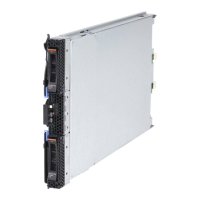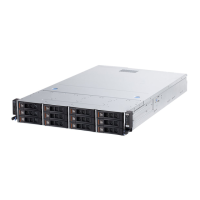52 IBM eX5 Implementation Guide
be assigned to SSD storage. When you must use memory swap files, assign the swap file
space to conventional SAS or SATA hard drives.
2.10.2 SSD drives and battery backup cache on RAID controllers
When using conventional SAS or SATA hard drives on a ServeRAID controller, it is common
practice to enable writeback cache for the logical drive to prevent data corruption if a loss of
power occurs.
With SATA SSD drives, writes to the drives are immediately stored in the memory of the SSD
drive. The potential for loss of data is dramatically reduced. Writing to writeback cache first
and then to the SSD drives actually increases the latency time for writing the data to the SSD
device.
Today’s SSD optimized controllers have neither read nor writeback cache. If you are in a solid
SSD environment, the best practice is to not install a RAID battery and to not enable cache.
When your storage uses a mixed media environment, the best practice is to use a
ServeRAID-5xxx controller with the IBM ServeRAID 5000 Performance Accelerator Key.
We describe this topic in detail in the following sections:
IBM System x3690 X5: 4.9.1, “2.5-inch SAS drive support” on page 145
IBM System x3850 X5: “ServeRAID M5000 Series Performance Accelerator Key” on
page 95
2.10.3 Increased resources for virtualization
The huge jump in processing capacity and memory allows for the consolidation of services,
while still maintaining fault tolerance using scalable clustered host solutions. As your servers
approach peak demand, additional hosts can be automatically powered on and activated to
spread the computing demand to additional virtual servers as demand increases. As the peak
demand subsides, the same environment can automatically consolidate virtual servers to a
smaller group of active hosts, saving power while still maintaining true fault tolerance.
By using larger servers with built-in redundancy for power, fans, storage access, and network
access, it is now possible to combine the functional requirements of a dozen or more servers
into a dual-hosted virtual server environment that can withstand the possible failure of a
complete host. As demand increases, the number of hosts can be increased to maintain the
same virtual servers, with no noticeable changes or programming costs to allow the same
virtual server to function in the new array of hosts.
With this capability, the server becomes an intelligent switch in the network. Instead of trying
to balance network traffic through various network adapters on various servers, you can now
create a virtual network switch inside a cluster of host servers to which the virtual servers
logically attach. All of the physical network ports of the server, provided that they are the
same type of link, can be aggregated into a single IEEE 802.3ad load balance link to
maximize link utilization between the server and the external network switch. Two scaled
x3850 X5s running in a clustered virtualized environment can replace an entire 42U rack of
conventional 1U servers, and their associated top rack network and SAN switch.
2.10.4 Virtualized Memcached distributed memory caching
Many web content providers and light provisioning providers use servers designed for speed,
and not fault tolerance, to store the results from database or API calls so that clients can be
redirected from the main database server to a MemCached device for all future pages within

